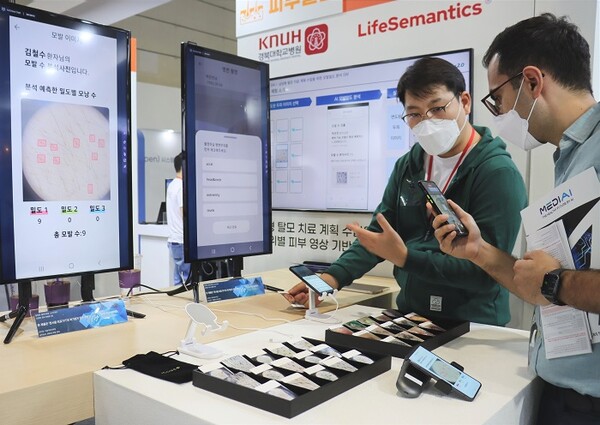"The digital health market has been driven mainly by technology-driven decisions, and they have not thought much about how to convince doctors, patients, and insurance payers to provide a better user experience. To grow the market further, however, more people must have commercializing minds.”

Hong Seung-yong, head of the MD Business Division at LifeSemantics, said so when asked recently about the capabilities needed by digital health companies at the company’s headquarters in Gangnam-gu, southern Seoul.
Hong, who served as chief marketing officer at Neofect after working at Johnson & Johnson and Boston Scientific Korea, took on the current role with the launch of LifeSemantics' Medical Device division this year. He oversees commercializing medical artificial intelligence solutions and DTx (digital therapeutic device) products.
"While working at a global pharmaceutical and medical device company, I was interested in data-related businesses, such as personal health records (PHRs)," Hong said, explaining his reasons for joining LifeSemantics. “Then I met LifeSemantics CEO Song Seung-jae and grabbed the opportunity to join the company with my experience in commercializing medical software (SW).
Hong explained that his role is to think about making LifeSemantics’ solutions easier for doctors and patients and what commercializing elements the company should put in.
“We are working with the R&D and software development teams to organize each item," Hong said. "As the digital healthcare industry grows, each company will increasingly need these elements."
LifeSemantics is developing four AI-based medical SWs through the government's “Doctor Answer 2.0 Project”: Skin cancer image detection and diagnosis aid SW, hair density analysis SW, home blood pressure prediction SW, and hypertension-related complication prediction SW.
Except for the hypertension complication prediction SW, the other three technologies have won approval for clinical trials by the Ministry of Food and Drug Safety (MFDS). They are expected to produce results early next year.
"In the case of the skin cancer image detection and diagnosis aid SW, we aim to introduce it to the market and medical field in the first half of next year through item license and deferred evaluation of new medical technology," Hong said. "It will be the first product LifeSemantics will introduce to the medical AI market. It will also be the first medical AI to assist in diagnosing skin cancer in Korea."
Besides, LifeSemantics is developing an AI-based prostate cancer diagnosis assistant SW. It plans to finalize the technology development and start clinical trials. Hong explained that AI will help improve the accuracy of prostate-specific antigen (PSA) testing, reducing painful biopsies for patients and convincing doctors that a biopsy is necessary.
Hong also emphasized the growing importance of measuring home blood pressure and the potential of the home blood pressure prediction SW currently under development. The SW is expected to motivate patients to measure and record their home blood pressure by predicting their next blood pressure in one to four weeks if they record their home blood pressure for eight weeks. In addition, the development of digital treatment devices based on blood pressure prediction algorithms is also under consideration.
On the other hand, the development of “Redpill Breath,” a digital therapy device for respiratory rehabilitation expected to receive the third domestic license as a digital therapy device, has entered a pause. It is preparing for the new medical technology evaluation deferral system. LifeSemantics aims to receive approval from the MFDS in January and complete the clinical trial in the second quarter of next year.
"For digital therapeutic devices to get insurance coverage in Korea, we cannot ignore the new medical technology assessment. Since we are considering the reimbursement application of Redpill Breath, we are trying to utilize the evaluation deferral system and are preparing for additional clinical trials. We plan to demonstrate non-inferiority through a comparative study with existing pulmonary exercise rehabilitation therapy (code MM440)."
Besides strengthening its competitiveness in the SW market, LifeSemantics also plans to enter the hardware medical device market. It draws a blueprint for the domestic distribution of medical devices in the diagnostic field through partnerships. It discusses various companies and plans to finalize its business target in the first quarter of 2024.
Regarding the Digital Medical Products Act pushed by the MFDS and the National Assembly, Hong said, "In the past, wellness products and medical devices were mixed and used without regard to their actual effectiveness, but in the future, clinical evidence will become an important purchase judgment criterion."

He noted that when the Digital Medical Products Act is in full swing, the healthcare and disease management-related industries will become even larger, and the market will change.
Asked to explain LifeSemantics' unique competitiveness, Hong said, "Unlike other medical AI companies that have developed solutions targeting specific medical information, LifeSemantics is pioneering the field of medical AI based on comprehensive medical data, such as lifelog data, genomic data, and clinical data. The potential is much greater."
Stressing that 2024 will be the year that LifeSemantics brings to market the products it has been working on in healthcare AI and DTx, one after the other, Hong said, “We look forward to generating revenues from our products and contributing to improving the quality of healthcare through our solutions and medical devices."
Related articles
- Drug regulator increases DTx budget by ₩2.3 billion
- LifeSemantics to reveal results for home blood pressure software trial in March
- LifeSemantics finishes technology demonstration of Dr.Call Thai
- LifeSemantics nears commercializing Korea’s 1st skin cancer diagnostic AI
- LifeSemantics gets nod for clinical trial of cardiovascular risk assessment AI

